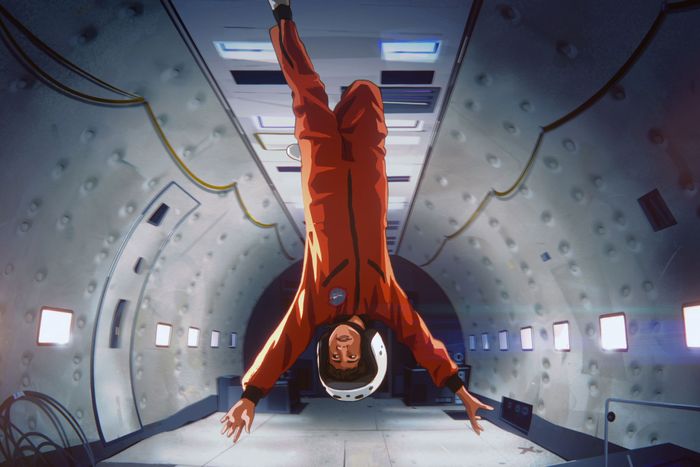
Richard Linklater must have had a spectacular adolescence to keep coming back to it in his movies, which regard the period with an ever-altering combination of affection and ruefulness. He has never aimed for straight autobiography in films like Dazed and Confused, Boyhood, and Everybody Wants Some!! Yet enough of the details are drawn from life that, in 2004, his former Huntsville High School classmates Richard “Pink” Floyd, Andy Slater, and Bobby Wooderson decided to sue Linklater for enshrining them onscreen in a haze of pot smoke and bad behavior. It’s questionable how seriously the complaint was meant to be taken. Not just because the lawsuit was dismissed, but because, despite Linklater’s insistence that he had set out to make a film opposed to nostalgia, Dazed and Confused felt like a comforting, if grubby, hug.
It was good to be a straight white guy who was good at sports in Texas in the ’70s, a fact that Linklater has always been able to approach with a near-miraculous guilelessness that makes his work inviting. That magic has drained away in Apollo 10½: A Space Age Childhood, an animated doodle of a movie set around the Apollo 11 mission and reveling in the textures of an old photo album. The film’s litany of details about growing up in the Houston area in the ’60s isn’t enveloping — instead, in its drone of vintage sitcom titles and reminiscences about fecklessly riding in the back of a pickup on the freeway to the beach, it feels, for the first time from Linklater, like a lecture about how things were better back then.
Apollo 10½ is animated, though it isn’t rotoscoped like Waking Life or A Scanner Darkly, Linklater’s earlier experiments in the medium. While there’s some performance capture, the film is otherwise a mix of 2-D and 3-D approaches, the analog animation style allowing the film to dip more seamlessly between recollection and unreality. Apollo 10½ is mostly about a summer in the life of Stan, who’s voiced as a kid by Milo Coy and as a backward-looking narrator by Jack Black. He’s the youngest of six siblings in a new development in the Houston suburbs, where his dad (Bill Wise) works in an administrative job at NASA. Stan’s is a regular life that the film injects with a touch of fancy by turning him into a recruit for a secret space mission piloting a lunar module that was accidentally built too small for any adult. While everyone else in his life believed him to be at summer camp in Michigan, he was undergoing rigorous training before being shipped off to the moon for a solo test run — a child’s astronaut fantasy rendered in practical terms, with the footage spliced into Stan’s more mundane experiences of watching the moon landing on television.
But that’s just a small slice of the movie, which is otherwise about the idyll of green lawns and drive-in double features that Stan exists in — baseball-inspired games invented to be played in the garage on rainy days, prank calls on the new push-button phone, Dark Shadows as appointment television, listening sessions in which his oldest sister, Vicky (Natalie L’Amoreaux), plays records and delivers opinions on the hidden meanings of songs. Even the elements of danger are given a golden glaze, from trips to the beach piled in the back of a pickup to the tongue-searing Popsicles the family eats at the pool. “Living in the Houston area in the late ’60s, and especially near NASA, was like being where science fiction was coming to life,” Black-as-Stan intones in the voice-over. “The optimistic technological future was now, and we were at the absolute center of everything new and better.”
There were riots and protests on the TV, he allows, and war in Vietnam, but for a kid in the suburbs, those were “all confined to the television.” The Apollo mission, with NASA’s headquarters just nearby, feels much more real and immediate to Stan, even if he watches it on the same screen. Apollo 10½ is lit with a yearning to convey what that optimism was like, given how far we are from it now, both temporally and emotionally. It can’t help but let the particular thrill of the space race seep into the rest of the film, until it becomes inextricable from Stan’s childhood memories. And yet it’s not actually the sequence in which the family watches the landing together — bringing out a smile even in radical Vicky, who describes the space race as a triumph for the squares — that feels most central.
Instead, the scene that’s most key to the film is one in which Stan’s dad carries him, sleeping, from the back of the car after a trip to the movies. “This was the last phase of childhood where I got to experience that special comfort of falling asleep in the car,” Stan observes. “You could drift off knowing that everything was going to be fine and the next morning you would wake up in your bed.” For all that Apollo 10½ tries to get at the imperfect hope for the future that fueled the decade, what the film really wants to crawl back into is the sensation of being a child blissfully asleep in a parent’s arms, sure that everything will be taken care of by those in charge.
More From This Series
- Fernanda Torres Is a Subtle Marvel in I’m Still Here
- Grand Theft Hamlet Is a Delightful Putting-on-a-Show Documentary
- Presence Is the Best Thing Steven Soderbergh’s Done in Ages


